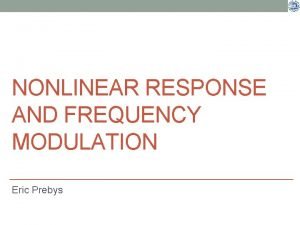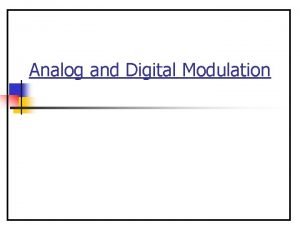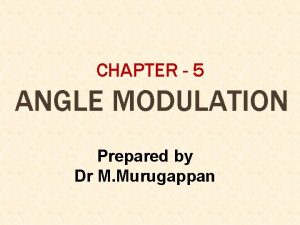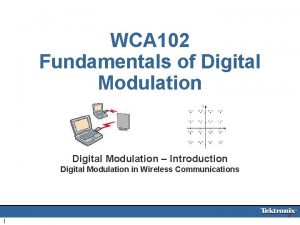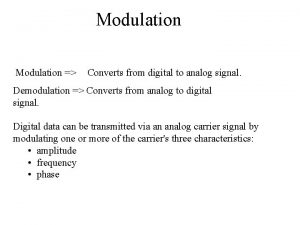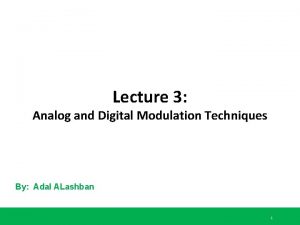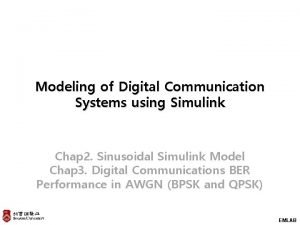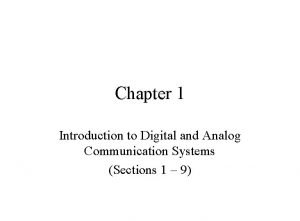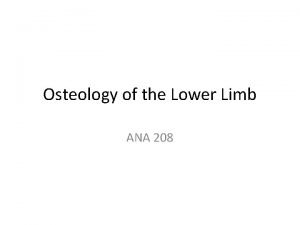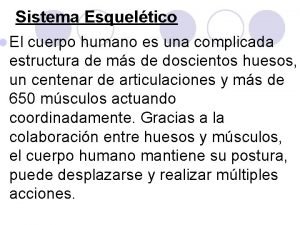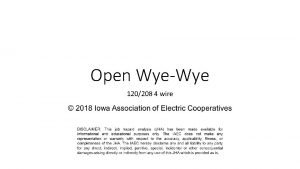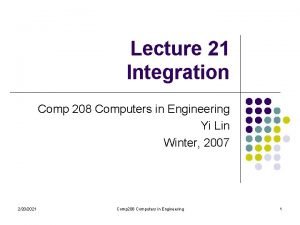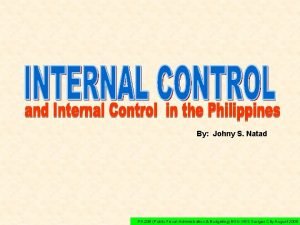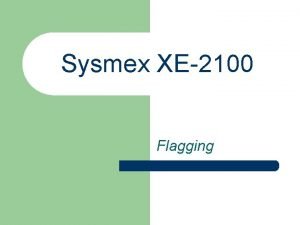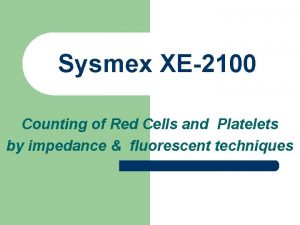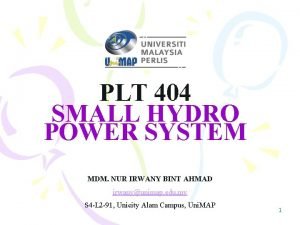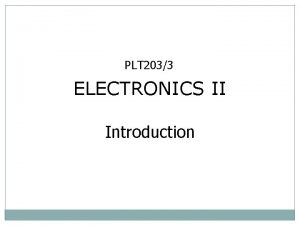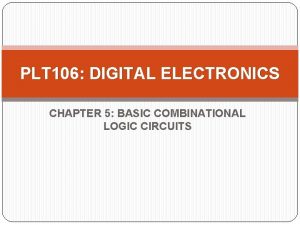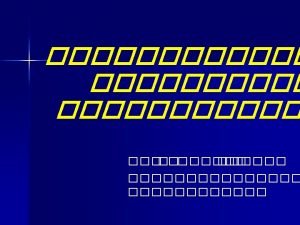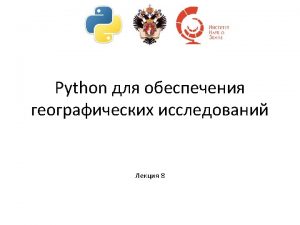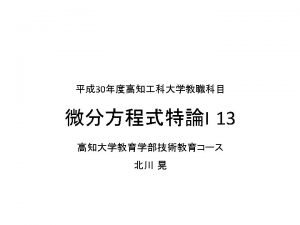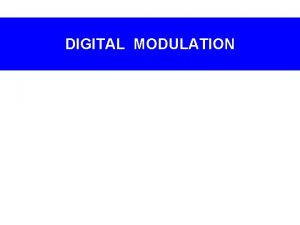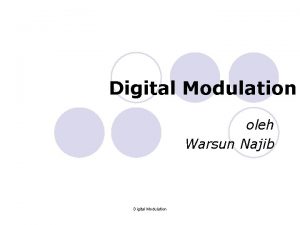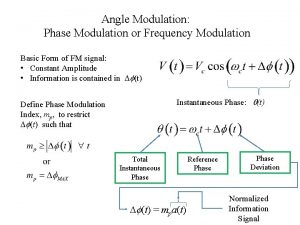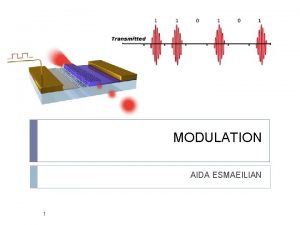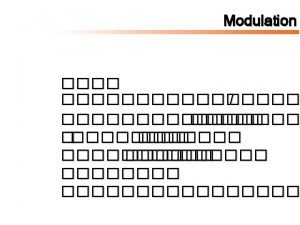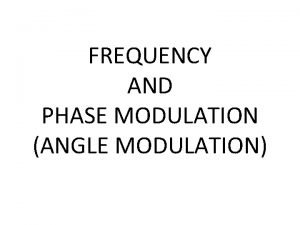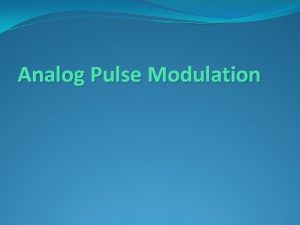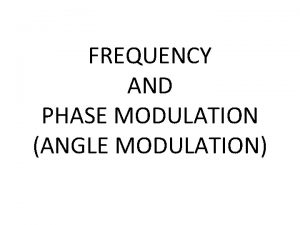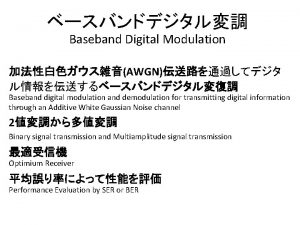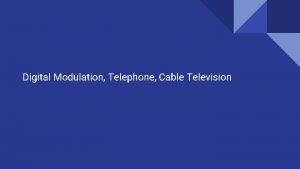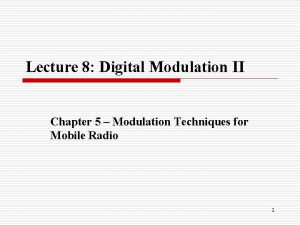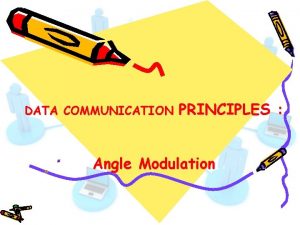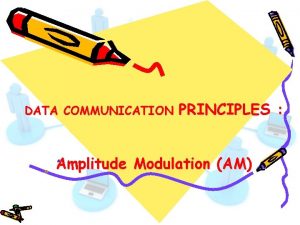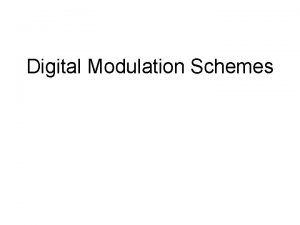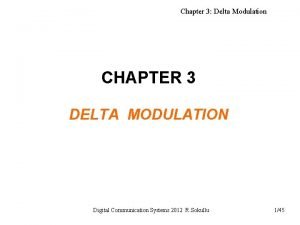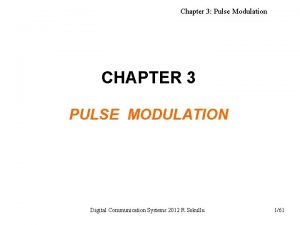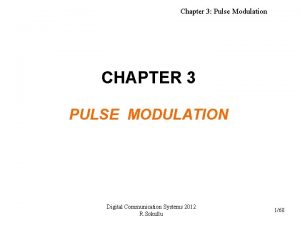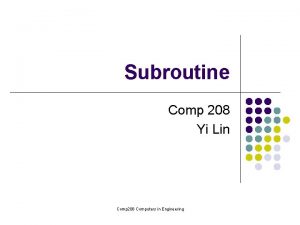PLT 208 COMMUNICATION SYSTEMS CHAPTER 4 DIGITAL MODULATION














































- Slides: 46

PLT 208 – COMMUNICATION SYSTEMS CHAPTER 4: DIGITAL MODULATION

DIGITAL MODULATION… a. b. c. Introduction to digital modulation Information capacity, Bits, Bit Rate, Baud, M-Ary Encoding Digital Modulation Techniques: - ASK - FSK - PSK - QAM PLT 208 – COMMUNICATION SYSTEMS

INTRODUCTION… �What is digital modulation? �transmittal of digitally modulated analog signals between two or more points in a communications system. �Sometimes called “digital radio”…WHY? . . . Digitally modulated signals can be propagated through Earth’s atmosphere and used in wireless communication system. �Offer several outstanding advantages over traditional analog system: �Ease of processing �Ease of multiplexing �Noise immunity PLT 208 – COMMUNICATION SYSTEMS

INTRODUCTION… � Applications: � Low speed voice band data communication modems � High speed data transmission systems (eg: broadband DSL) � Digital microwave & satellite communication systems � PCS (Personal Communication Systems) telephone �Digital Communication: �System where relatively high-frequency analog carriers are modulated by relatively low-frequency digital information signals (digital radio) �Systems involving the transmission of digital pulses (digital SYSTEMS transmission) PLT 208 – COMMUNICATION

INTRODUCTION… �Digital Transmission: �Transport information in digital form �Require a physical facility between the transmitter and receiver ( eg: metallic wire pair, coaxial cable, optical fiber cable) �Property distinguishes digital radio systems from conventional analog-modulation communications systems: �Nature of the modulating signal �Both system use analog carriers to transport information �But, �analog modulation - information signal is analog PLT 208 – COMMUNICATION SYSTEMS

Why digital modulation? �The modulation of digital signals with analogue carriers allows an improvement in signal to noise ratio as compared to analogue modulating schemes. PLT 208 – COMMUNICATION SYSTEMS

Important Criteria… 3. 4. 5. 6. High spectral efficiency High power efficiency Robust to multipath Low cost and ease of implementation Low carrier-to-co channel interference ratio Low out-of-band radiation 7. 8. Constant or near constant envelop Bandwidth Efficiency 1. 2. Ability to accommodate data within a limited bandwidth Tradeoff between data rate and pulse width 9. Power Efficiency To preserve the fidelity of the digital message at low power levels. Can increase noise immunity by increasing signal power PLT 208 – COMMUNICATION SYSTEMS

Forms of Digital Modulation… • If the amplitude, V of the carrier is varied proportional to the information signal, a digital modulated signal is called Amplitude Shift Keying (ASK). • If the frequency, f of the carrier is varied proportional to the information signal, a digital modulated signal is called Frequency Shift Keying (FSK). • If the phase, θ of the carrier is varied proportional to the information signal, a digital modulated signal is called Phase Shift Keying (PSK). • If both the amplitude and the phase, θ of the carrier are varied proportional to the information signal, a digital modulated signal is called Quadrature Amplitude Modulation (QAM). PLT 208 – COMMUNICATION SYSTEMS

PLT 208 – COMMUNICATION SYSTEMS

EXAMPLE 1 For the digital message 1101 1100 1010, sketch the waveform for the following: a. ASK b. FSK c. PSK d. QAM PLT 208 – COMMUNICATION SYSTEMS

Block Diagram… Simplified block diagram of a digital modulation system PLT 208 – COMMUNICATION SYSTEMS

Block Diagram… � In Tx, precoder performs level conversion & encodes incoming data into group of bits that modulate an analog carrier. � Modulated carrier filtered, amplified & transmitted through transmission medium to Rx. (eg: metallic cable, optical fiber cable, Earth’s atmosphere) � In Rx, the incoming signals filtered, amplified & applied to the demodulator and decoder circuits which extracts the original source information from modulated carrier. PLT 208 – COMMUNICATION SYSTEMS

INFORMATION CAPACITY, BITS, BIT RATE, BAUD & M-ARY ENCODING �Information capacity, Bits & Bit Rate �Represents the number of independent symbols that can be carried through a system in a given unit of time. �Basic digital symbol is the binary digit or bit. �Express the information capacity as a bit rate. PLT 208 – COMMUNICATION SYSTEMS

Hartley’s Law �Where I = information capacity (bps) B = bandwidth (Hz) t = transmission time (s) �From the equation, Information capacity is a linear function of bandwidth and transmission time and directly proportional to both. PLT 208 – COMMUNICATION SYSTEMS

Shannon’s Formula �Where I = information capacity (bps) B = bandwidth (Hz) S/N = signal to noise power ratio (unitless) �The higher S/N the better the performance and the higher the information capacity PLT 208 – COMMUNICATION SYSTEMS

EXAMPLE 2 By using the Shannon’s Formula, calculate the information capacity if S/N = 30 d. B and B = 2. 7 k. Hz. PLT 208 – COMMUNICATION SYSTEMS

M-ARY ENCODING… � It is often advantageous to encode at a level higher than binary where there are more than two conditions possible. � The number of bits necessary to produce a given number of conditions is expressed mathematically as Where N = number of bits necessary M = number of conditions, level or combinations possible with N bits. � Each symbol represents n bits, and has M signal states, where M = 2 N. PLT 208 – COMMUNICATION SYSTEMS

EXAMPLE 3 Find the number of voltage levels which can represent an analog signal with a. 8 bits per sample b. 12 bits per sample PLT 208 – COMMUNICATION SYSTEMS

BAUD & MINIMUM BANDWIDTH… �Baud refers to the rate of change of a signal on the transmission medium after encoding and modulation have occurred. Where baud = symbol rate (symbol @ baud per second) ts = time of one signaling element @ symbol (seconds) PLT 208 – COMMUNICATION SYSTEMS

BAUD & MINIMUM BANDWIDTH… �H. Nyquist – binary digital signals can be propagated through an ideal noiseless transmission medium at a rate equal to two times the bandwidth of the medium. �Minimum Nyquist bandwidth – minimum theoretical bandwidth necessary to propagated a signal. (minimum Nyquist frequency). Thus, fb = bit rate in bps bandwidth PLT 208 – COMMUNICATION SYSTEMS B = ideal Nyquist

BAUD & MINIMUM BANDWIDTH… �Actual bandwidth necessary to propagated given bit rate depends on several factors: �Type of encoding & modulation used �Types of filters used �System noise �Desired error performance �Ideal bandwidth – generally used for comparison purpose only PLT 208 – COMMUNICATION SYSTEMS

BAUD & MINIMUM BANDWIDTH… � Minimum Bandwidth �Using multilevel signaling, the Nyquist formulation for channel capacity Where fb= channel capacity (bps) B = minimum Nyquist bandwidth (Hz) M = number of discrete signal or voltage levels PLT 208 – COMMUNICATION SYSTEMS

BAUD & MINIMUM BANDWIDTH… For B necessary to pass M-ary digitally modulated carriers Where N is the number of bits encoded into each signaling element. PLT 208 – COMMUNICATION SYSTEMS

DIGITAL MODULATION TECHNIQUES… �Amplitude Shift Keying (ASK) �Frequency Shift Keying (FSK) �Phase Shift Keying (PSK) �Quadrature Amplitude Modulation (QAM) PLT 208 – COMMUNICATION SYSTEMS

AMPLITUDE –SHIFT KEYING (ASK)… � A binary information signal directly modulates the amplitude of an analog carrier. � Sometimes called Digital Amplitude Modulation (DAM) Where vask (t) = amplitude shift keying wave vm(t) = digital information signal (volt) A/2 = unmodulated carrier amplitude (volt) ωc = analog carrier radian frequency (rad/s) PLT 208 – COMMUNICATION SYSTEMS

AMPLITUDE –SHIFT KEYING (ASK)… Digital Amplitude Modulation PLT 208 – COMMUNICATION SYSTEMS

FREQUENCY-SHIFT KEYING (FSK)… � Called as Binary Frequency Shift Keying (BFSK) � The phase shift in carrier frequency (∆f) is proportional to the amplitude of the binary input signal (vm(t)) and the direction of the shift is determined by the polarity Where vfsk(t) = binary FSK waveform Vc = peak anlog carrier amplitude (volt) fc = analog carrier center frequency (Hz) ∆f = peak shift in analog carrier frequency (Hz) vm(t) = binary input signal (volt) PLT 208 – COMMUNICATION SYSTEMS

FREQUENCY-SHIFT KEYING (FSK)… PLT 208 – COMMUNICATION SYSTEMS

FREQUENCY-SHIFT KEYING (FSK)… PLT 208 – COMMUNICATION SYSTEMS

FREQUENCY-SHIFT KEYING (FSK)… Binary Input Frequency Output 0 Space (fs) 1 Mark (fm) PLT 208 – COMMUNICATION SYSTEMS

Example 4 Given a binary FSK signal with a mark frequency of 49 k. Hz, a space frequency of 51 k. Hz and an input bit rate of 2 kbps. Determine (a) Peak frequency deviation (b) Minimum bandwidth (c) Baud for a binary FSK

PHASE-SHIFT KEYING (PSK)… � Another form of angle-modulated, constant amplitude digital modulation. � Binary digital signal input & limited number of output phases possible. � M-ary digital modulation scheme with the number of output phases defined by M. � The simplest PSK is Binary Phase-Shift Keying (BPSK) �N= 1, M=2 �Two phases possible for carrier with one phase for logic 1 and another phase for logic 0 �The output carrier shifts between two angles separated by 180° PLT 208 – COMMUNICATION SYSTEMS

PHASE-SHIFT KEYING (PSK)… a) Truth Table PLT 208 – COMMUNICATION SYSTEMS b) Phasor Diagram c) Constellation Diagram

PHASE-SHIFT KEYING (PSK)… BPSK Transmitter PLT 208 – COMMUNICATION SYSTEMS

PHASE-SHIFT KEYING (PSK)… BPSK Receiver PLT 208 – COMMUNICATION SYSTEMS

CONSTELLATION DIAGRAM… Definition : A graphical representation of the complex envelope of each possible symbol state. q The x-axis represents the in-phase component and the y-axis the quadrature component of the complex envelope q The distance between signals on a constellation diagram relates to how different the modulation waveforms are and how easily a receiver can differentiate between them. PLT 208 – COMMUNICATION SYSTEMS

CONSTELLATION DIAGRAM… PLT 208 – COMMUNICATION SYSTEMS

BPSK PLT 208 – COMMUNICATION SYSTEMS

EXAMPLE 5 For a BPSK modulator with a carrier frequency of 70 MHz and an input bit rate of 10 Mbps, determine : (a) Maximum and minimum upper and lower side frequencies (b) Draw the output spectrum (c) Minimum Nyquist bandwidth and baud (formula not given) PLT 208 – COMMUNICATION SYSTEMS

QPSK Output

Example 6 For a QPSK modukator with an input data rate (fb) equal to 10 Mbps and a carrier frequency of 70 MHz, determine the minimum double-sided Nyquist bandwidth (Fn) and baud. Compare result with example 5. page 364 (formula not given)

QUADRATURE-AMPLITUDE MODULATION (QAM)… �Combine amplitude and phase-shift keying. �Method of voice band data transmission. �QAM = 4 -PSK PLT 208 – COMMUNICATION SYSTEMS

QUADRATURE-AMPLITUDE MODULATION (QAM)… PLT 208 – COMMUNICATION SYSTEMS

QUADRATURE-AMPLITUDE MODULATION (QAM)… Amplitude and phase shift keying can be combined to transmit several bits per symbol. � Often referred to as linear as they require linear amplification. � More bandwidth-efficient, but more susceptible to noise. For M = 4, 16 QAM has the largest distance between points, but requires very linear amplification. 16 PSK has less stringent linearity requirements, but has less spacing between constellation points, and is therefore more affected by noise. High level M-ary schemes (such as 64 -QAM) are very bandwidth-efficient but more susceptible to noise and require linear amplification PLT 208 – COMMUNICATION SYSTEMS

Bandwidth Efficiency… �Sometimes called information density or spectral efficiency �Used to compare the performance of one digital modulation technique to another. Bη = Transmission bit rate (bps) Minimum bandwidth (Hz) PLT 208 – COMMUNICATION SYSTEMS

SUMMARY… � To decide which modulation method should be used , we need to make considerations of a) Bandwidth b) Speed of Modulation c) Complexity of Hardware PLT 208 – COMMUNICATION SYSTEMS
 Amplitude modulation vs frequency modulation
Amplitude modulation vs frequency modulation Amplitude modulation vs frequency modulation
Amplitude modulation vs frequency modulation Advantages of angle modulation over amplitude modulation
Advantages of angle modulation over amplitude modulation Advantages of digital modulation
Advantages of digital modulation Modulation digital to analog
Modulation digital to analog Analog and digital modulation techniques
Analog and digital modulation techniques Advantages and disadvantages of binary code
Advantages and disadvantages of binary code Modeling of digital communication systems using simulink
Modeling of digital communication systems using simulink Analog vs digital communication systems
Analog vs digital communication systems Modeling of digital communication systems using simulink
Modeling of digital communication systems using simulink Ics 208
Ics 208 Inguinal canal diagram
Inguinal canal diagram The verb ser (p. 158) answers
The verb ser (p. 158) answers Pl 107-208
Pl 107-208 Regex xkcd
Regex xkcd Level 2 pp. 208-210 answers
Level 2 pp. 208-210 answers Memory express
Memory express 136xe isotope
136xe isotope What is standard notation
What is standard notation 208 huesos del cuerpo humano
208 huesos del cuerpo humano Directional perm wind
Directional perm wind 120/208 wye wye bank
120/208 wye wye bank Plastic compression molding
Plastic compression molding 208 rmb
208 rmb Comp 208
Comp 208 208 huesos del cuerpo humano
208 huesos del cuerpo humano Pa 208
Pa 208 Opendns family shield
Opendns family shield Lymphl
Lymphl Plt abn distribution
Plt abn distribution Mdm hydra
Mdm hydra Striscio di sangue
Striscio di sangue Plt scheme
Plt scheme Plt fuzzy set
Plt fuzzy set Plt electronics
Plt electronics Plt 106
Plt 106 Introduction to high voltage technology
Introduction to high voltage technology Fcps my plt
Fcps my plt Plt in cbc
Plt in cbc Plt uts
Plt uts คืออะไร
คืออะไร คืออะไร
คืออะไร Import numpy as np import matplotlib.pyplot as plt
Import numpy as np import matplotlib.pyplot as plt Gdlp anu
Gdlp anu Plt
Plt Communication model
Communication model Billy b and plt
Billy b and plt
